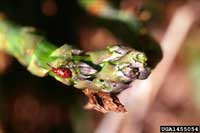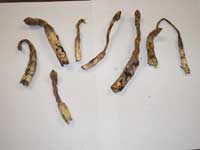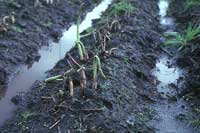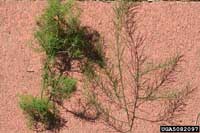Extension > Garden > Diagnose a problem > What's wrong with my plant? > Vegetable > Asparagus > Deformed spear
Asparagus > Spear > Deformed spear
1 of 4
Common Asparagus Beetle
Crioceris asparagi
- Adult feeding on asparagus spear causes spear to bend over into a shepherd's crook
- Adults also feed on ferns; can severely defoliate plant
- Larvae are slug-like, and light gray with a black head
- Adult beetles are ¼ inch long, oval-shaped, bluish-black with six cream colored spots on its back
- More information on Common Asparagus Beetle
2 of 4
Spotted Asparagus Beetle
Crioceris duodecimpunctata
- Adult feeding on asparagus spear causes spear to bend over into a shepherd's crook
- Larvae feed on berries, but do not damage the overall health of the plant
- Adult beetles are ¼-inch long, oval-shaped, reddish-orange with twelve black spots
- Larvae are slug-like, and yellowish-orange
- More information on Spotted Asparagus Beetle
3 of 4
Phytophthora Crown and Spear Rot
Phytophthora megasperma
- Spear has a soft dark water soaked lesion at the soil line
- Spear curls over the infected side and eventually collapses
- Infected part of spear is slimy and may smell bad
- Roots have water soaked spots
- Crown turns yellow
- In severe infections plant may die
- More information on Phytophthora Crown and Spear Rot
4 of 4
Asparagus Aphid
Brachycorynella asparagi
- Feed on asparagus fern
- Aphid causes "witch's broom", a bushy appearance to the ferns
- High aphid populations will reduce plant vigor and yield or kill seedlings
- Active during spring and summer
- Small insects (1/10th inch long), pear-shaped, pale green and powdery













